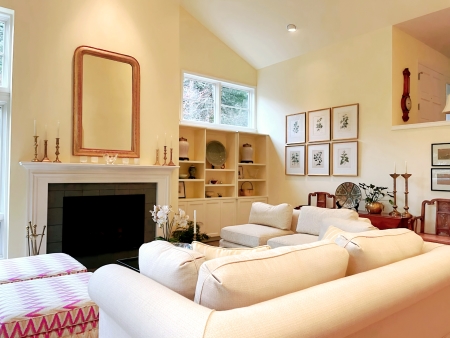How Lighting Impacts the Colors in Your Rooms: A Guide to Choosing the Perfect Shade

Choosing the right paint color for your home can be challenging, especially when lighting significantly affects how colors appear. Natural and artificial lighting have unique impacts on color tones and the mood of your space. Here’s a guide on how lighting influences room colors and tips on finding the perfect palette for every room in your home.
Natural Light and Its Effects:
Morning Sunlight:
Rooms exposed to morning sunlight tend to have a cooler, bright light that highlights cool colors like blues and greens, giving them a more vibrant appearance. Meanwhile, warmer colors, like reds and oranges, may appear more muted, which can create a calm, relaxing feel.
Afternoon Sunlight:
As sunlight warms up in the afternoon, it can intensify warm colors, making them feel even cozier, while sometimes washing out lighter, cooler tones. For spaces that see this warm light, consider balancing with neutral tones or lighter shades to prevent overpowering warmth.
Northern Exposure:
North-facing rooms receive the least direct sunlight, creating cooler, more subdued lighting. This can make rooms feel a bit “chillier” in tone, so it’s often best to choose warmer shades that add a sense of warmth and comfort to these spaces.
Southern Exposure:
Rooms with southern exposure bask in consistent, warm sunlight throughout the day. This type of light enhances both cool and warm colors beautifully but be cautious with bold colors, as they can appear extra intense.
The Role of Artificial Light:
Incandescent Bulbs:
These emit a warm, yellowish glow that emphasizes warm colors like reds, yellows, and oranges, making them feel richer. Cooler colors, like blues and greens, may appear softer and less vibrant under incandescent light.
Fluorescent Bulbs:
Known for their cooler, bluish hue, fluorescent lighting tends to enhance cool colors, making blues and greens feel crisp and clean. However, warm colors might look slightly duller, so it’s important to consider where you place fluorescents.
LED Bulbs:
With a broad range of color temperatures, LEDs offer versatility. Warm white LEDs (2700K-3000K) create a cozy, inviting glow similar to incandescent light, while daylight LEDs (5000K-6500K) mimic natural daylight, offering true-to-life color.
Lighting Impacts by Room:
Living Room:
Natural Light: In a living room with ample sunlight, lighter, neutral tones will reflect light, creating a spacious feel. For north-facing spaces, warmer hues can make the room feel more inviting.
Artificial Light: Use warm incandescent bulbs for a cozy ambiance. Shades like beige, warm gray, and earthy tones work well to enhance comfort.
Kitchen:
Natural Light: Kitchens with southern exposure can handle bold, bright colors due to the ample natural light. For subtler spaces, soft blues and greens provide a fresh, clean aesthetic.
Artificial Light: Under-cabinet LED lighting in cooler tones can make whites, blues, and greens feel vibrant and clean, which is ideal for food prep areas.
Bedroom:
Natural Light: Bedrooms with limited natural light benefit from light, warm colors for a serene and restful vibe. Soft pastels and neutrals work wonderfully here.
Artificial Light: Soft, warm lighting from incandescent or warm LED bulbs can create a relaxing atmosphere, perfect for unwinding.
Bathroom:
Natural Light: If your bathroom has abundant natural light, it can support a range of colors. Light cool tones can enhance the feeling of cleanliness and spaciousness.
Artificial Light: Bright, cool white LED bulbs are a great choice, as they’re perfect for grooming tasks, helping cool colors stand out and giving a fresh feel to the space.
Tips for Choosing Colors Based on Lighting:
- Test Paint Samples: Apply swatches on different walls to see how the color changes throughout the day.
- Consider Bulb Types: Think about the type of lighting you use most in each room and how it will affect the paint.
- Balance Light and Color: In darker rooms, opt for lighter shades to make the space feel larger. Brighter rooms can support deeper or more saturated colors.
Lighting transforms color and affects the mood of your rooms. By understanding the impact of lighting on color, you’ll create spaces that are not only visually appealing but also perfectly suited to your lifestyle. Choose wisely and watch your home come to life in the most beautiful way.
Ready To Transform Your Space With Expert Color Consultation And Seamless Project Management? Schedule With Our Color Consultants And Let's Bring Your Vision To Life!